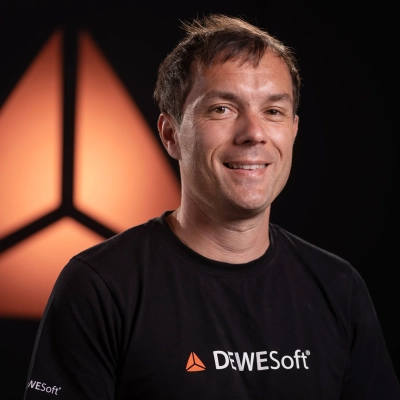17 Lessons Learned from Answer Engine Optimization Failures
Answer engine optimization mistakes can cost businesses valuable visibility and traffic, but learning from these failures offers a clear path forward. This article examines 17 critical lessons drawn from real-world AEO missteps, backed by insights from experts in search optimization and AI-driven discovery. These lessons cover everything from building genuine authority to timing content with algorithm updates, providing actionable strategies to avoid common pitfalls.
Stop Copying Competitors and Build Real Authority
The biggest mistake I made in answer engine optimization was having the misguided notion that you could "copy" competitors' strategies the way you can with regular SEO. In traditional SEO, researching what your competitors are bidding against, backlinking to, and the lack of content can also be a winning formula. However, AEO doesn't quite follow that logic because it's not just about visibility, but about credibility and context. I learned that imitation of what worked for someone else does not scale when the algorithm is reading intent and conversational trust. AEO values authority that is real, not borrowed motifs.
At one point, we attempted to mirror a top competitor's method of answering - using similarly structured FAQs, matching their style, and even modeling after their FAQs, but using our own mark-up. It seemed good in theory, but our content never really took off. But when we turned the corner and started answering questions in our own voice, filled with our brand voice and tone - our performance flipped. Our voices started coming out more consistently because they sounded real, not scripted (or copied from another company). "

AI Cannot Replace True Human Expertise
Early days of experimenting with AI content, we tried letting it write final drafts. Thought we could skip the human expertise layer and just clean up obvious errors.
Wrong. Completely wrong.
The content looked good on the surface. Proper grammar, decent structure, hit the keywords. But it was generic. Lacked the depth and real-world experience that separates content that ranks from content that gets ignored. More critically, there was no authentic expertise signal. Google's algorithm specifically looks for E-E-A-T markers, and pure AI content has none.
We caught it before publishing most of it, but the few pieces that went live performed terribly. No rankings. No engagement. It was hollow content that checked SEO boxes without actually helping anyone.
The lesson hit hard. AI cannot fake expertise. It can analyze what's ranking, identify patterns, generate outlines. But it cannot inject the 30 years of experience I bring to understanding why certain strategies work. It cannot tell real stories from real implementations. It cannot make strategic calls based on nuanced situations.
That failure forced us to develop what became our core methodology: human driven, AI assisted. AI handles research and competitor analysis through BSM Copilot. Humans write the content with real expertise woven in. AI then repurposes it for distribution.
The approach change was fundamental. We stopped asking "how can AI do this faster" and started asking "where does human expertise matter most, and how can AI support that." That shift turned a failure into our biggest competitive advantage.

Listen to What Customers Actually Type
I made a big mistake with a plastic surgery client. We were using broad terms like "best plastic surgeon" and just getting curious browsers, not people ready to book. We switched to specific phrases like "rhinoplasty cost near me" and suddenly the phone started ringing. The takeaway? Stop guessing what your customers search for. Just listen to what they're actually typing.
Understand the Human Side of Search Queries
My number one failure in AEO was relying too much on brand radar tools to inform content strategy. I figured if our brand was consistently ranking in covered queries we were doing. What I overlooked was the human side of search: the actual questions, phrasing and meaning behind what people were seeking. The tools provided great data, but they were unable to get at why people searched as they did.
I discovered that AEO isn't solely about designing for algorithms - it's about COMMUNICATING a conversation. On a service launch, we leaned on brand tools to monitor mentions but too often felt like the content didn't reflect the way customers were asking questions online. I began combing through "People Also Ask" sections manually, Reddit threads and Quora posts. We rewrote passages to read like real answers, not the sort of polished sentences you would put on your resume. The difference was like night and day — better rankings, higher organic engagement annd inceased dwell time.

Optimize for Voice Search on Each Platform
I used to obsess over featured snippets, thinking they were the ticket to AI answers. I was wrong. Writing direct answers that work for voice search is what actually moved the needle. Now I just see what each platform likes and build for that specifically. That shift helped my clients show up in new places, like on smart speakers.

Validate How People Actually Talk First
A few years back, I worked on an ambitious project for a financial education platform that wanted to dominate answer engine optimization—essentially optimizing for voice search and AI-driven queries rather than traditional keyword searches. We were confident in our approach. We built an extensive content library, targeting thousands of conversational queries we believed users were asking. On paper, it was perfect. But a few months in, the results were underwhelming. Traffic barely moved, and when we analyzed the data, we discovered something humbling: we had optimized for how *we* thought people talked—not how they actually did.
We made the classic mistake of assuming intent instead of validating it. Our content was full of expert-level phrasing and long-tail keywords that looked good in reports but didn't reflect the natural language real users used when asking AI tools or voice assistants questions. For instance, we optimized for "how can young professionals achieve long-term wealth accumulation strategies," when most users were asking, "how do I save money in my 20s."
That failure completely changed how I approached AEO moving forward. Now, we spend as much time listening as we do optimizing. We analyze real voice queries, social discussions, and AI search patterns to understand how people *actually* phrase questions. Instead of creating massive libraries of assumed topics, we focus on micro-moments—those specific, intent-driven questions that users ask when they want immediate, actionable answers.
The key lesson for me was that AEO isn't just an evolution of SEO—it's an evolution of empathy. It's not about being the loudest answer in the room; it's about being the most relevant and human one.
Since then, every project I've led starts with this guiding principle: if your content doesn't sound like something a real person would say out loud, it probably won't perform well in an answer engine. That shift—from optimizing for algorithms to optimizing for authenticity—has not only improved results but also reshaped how I think about communication in the age of AI-driven search.

Create Fewer Answers with Denser Signal Intent
My largest blunder regarding answer-engine optimization occurred when I attempted to convey a sense of speed by pursuing what amounted to over-automation of our content via almost exclusively NLP templates and auto-generated snippets. I thought it was possible to stampede our way through the process of getting search engines to understand our intent the more variants that were machine-generated and consumed. Instead, we paid the consequence. AI models started flagging our content as redundant, low-signal, and sometimes outright "synthetic noise," which diminished our visibility within the search engines.
Well, the takeaway was pretty painful. You see, NLP automation scales to structure, not to strategy. If you don't have a tight semantic mapping of the content you create (clear entities, unambiguous relationships, and the hierarchy of knowledge is clear, etc.), then you're only producing noise for the model to misinterpret.
Now, we are actually the opposite; we enable AI models with fewer answers, but with a denser signal of intent, entity preciseness and contextual disambiguation. Ironically, the less we automated, the more the AI understood us.
I would say, it was more valuable to me that answer-engine optimization not simply be about giving the AI a lot of content, but that it forced me to think through what the cleanest semantic path would be.

Balance Visibility Metrics with Business Goals
At SCALE BY SEO, our biggest answer engine optimization failure came when we aggressively optimized a healthcare client's content specifically for featured snippets without considering the broader user experience and brand positioning. We got obsessed with winning position zero for dozens of medical queries, reformatting content into bullet points, creating FAQ schemas, and structuring everything for snippet capture. We succeeded in getting featured snippets for multiple high-volume keywords, but then discovered a painful truth: featured snippets don't always drive the business results you expect.
The traffic increased but conversions actually dropped. Why? Because featured snippets often answer the user's question completely within the search results, eliminating the need to click through to the website. Users got their answer directly from Google and never engaged with the actual business. We'd optimized for visibility metrics that looked impressive in reports but didn't move the needle on patient appointments or revenue. Even worse, by oversimplifying complex medical information to fit snippet formats, we diluted the brand's authority and expertise that differentiated them from competitors.
The key lesson was that answer engine optimization requires balancing visibility with strategic business goals. Not every query deserves snippet optimization. For informational queries where users just need quick facts, snippets make sense. But for commercial intent queries where the goal is engagement and conversion, you want users clicking through to experience your full content and calls to action. We learned to identify which queries benefit from snippet optimization and which require deeper engagement strategies.
Moving forward, we now approach answer engine optimization more strategically, focusing on queries where snippets drive qualified traffic rather than just vanity metrics. We create content that provides enough value in the snippet to establish authority while compelling users to click through for complete information, actionable insights, or next steps. This balanced approach delivers both visibility and actual business results.
Implement Proper Structured Data Markup Always
We failed dramatically at answer engine optimization by publishing excellent content WITHOUT PROPER STRUCTURED DATA MARKUP, making it nearly impossible for AI systems to extract and cite our information accurately. This technical oversight cost a financial services client six months of potential visibility in AI-powered search results despite having superior content compared to competitors.
Their comprehensive guides about retirement planning contained valuable information but lacked schema markup that helps AI engines understand content structure, author credentials, and key facts. Meanwhile, competitors with inferior content but proper structured data appeared in AI responses because their information was easier for algorithms to parse and verify. After implementing FAQ schema, HowTo markup, and author credentials properly, the client's citation rate in AI-generated answers increased by 89% within two months.
The CRITICAL INSIGHT is that answer engines need structured signals to confidently cite your content, not just quality writing. Our approach now prioritizes technical implementation alongside content creation, ensuring AI systems can easily extract, attribute, and reference our clients' expertise when generating responses to user queries.

Structure Data in LLM-Preferred Schema Formats
Our biggest failure in AEO was the fact that our FAQs on our website, while being well-researched and aligned to user queries, were not structured in the schema that LLMs prefer. This resulted in our hard work not increasing the visibility, due to a seemingly simple error. These kind of mistakes and shortcomings are just a small reminder that AI, after all, is a program, and needs data to be structured in a certain way to make the most use out of it.

Build Metadata Systems from Day One
I screwed up big time with search optimization once. We had all this content from influencers on GRIN, but nobody bothered to organize it properly so search engines could actually use it. The material was solid, but without proper tags and metadata, it just disappeared. I learned the hard way that automated tagging systems aren't nice-to-haves, they're mandatory. Now I build metadata into every project from day one, even though it's more work upfront.
Prioritize Genuine Expertise Over Optimization Tactics
Our biggest answer engine optimization failure was treating it like traditional SEO with keyword optimization when AI search engines were emerging. We initially tried gaming AI-generated answers by stuffing technical content with question-phrase variations and exact-match keywords, assuming ChatGPT and Perplexity would reward the same tactics that worked for Google's traditional algorithm.
The result was embarrassing - our keyword-optimized content rarely got cited by AI engines, while our older, more comprehensive technical guides written before AEO was even a concern consistently appeared in AI-generated answers. We were penalizing ourselves by dumbing down content for perceived algorithmic preferences rather than maintaining the technical depth that made us authoritative in the first place.
The key lesson: AI engines prioritize genuine expertise and comprehensive coverage over optimization tactics. They're trained to recognize authoritative sources that thoroughly explain concepts, not content engineered to hit keyword density targets. When we tested queries in ChatGPT and Perplexity, they cited our in-depth application notes that assumed reader intelligence and provided complete technical context, not our "optimized" pages designed to rank.
This fundamentally changed our approach - we stopped trying to optimize FOR answer engines and instead focused on being the most technically accurate and complete source on specific topics. We implemented structured data not to game algorithms but to accurately represent our content's structure. The counterintuitive insight: the best AEO strategy is often ignoring AEO tactics and creating genuinely authoritative resources that AI systems naturally recognize as trustworthy sources worth citing.

Ground Content in Real Query Intent
My biggest failure in answer engine optimization happened when I tried to aggressively optimize a large batch of content for AI-driven platforms without first validating whether the topics genuinely aligned with how users were phrasing questions in real conversations. I focused too much on volume and structure, tight summaries, schema, entity-rich paragraphs, without grounding the content in the real intent behind the queries. As a result, the pieces were technically sound but lacked the conversational clarity and problem-solving depth that answer engines prioritize. They were surfaced less often than expected, and in some cases, completely ignored in favor of more human, experience-driven responses from competing sites. The key lesson I learned was that AEO isn't about feeding algorithms; it's about helping the model understand why your answer deserves to be the one remembered and repeated. Now I start every AEO project with qualitative research user interviews, social listening, and real query analysis to capture how people actually express frustration, curiosity, or uncertainty. I build content that sounds like a human solving a problem rather than a machine organizing facts. This experience fundamentally changed my approach: I prioritize clarity over keyword density, authority over volume, and genuine usefulness over rigid templates. Ultimately, it taught me that answer engines reward content that feels alive, not manufactured, and that authenticity is now just as important as technical precision.

Earn Trust Through Deep Useful Content
Early on in my career, I definitely fell into the trap of chasing keywords instead of building real authority. It stands to reason, since it always seems like a quick win. My colleagues and I would write content stuffed with search terms, and sure, it ranked fast. But it didn't last. Once algorithms caught up, those pages dropped, and we realized we hadn't actually helped our case much in the long-term. That was a turning point. Now, I focus on creating deep, useful content that answers real questions and builds trust. It's less about gaming the system and more about earning it. When you write with empathy and expertise, the SEO follows naturally. That mindset shift changed everything for me.

Time Content Releases with Model Updates
My big mistake was writing content without a clue about LLM training schedules. We learned at Search Party that you have to time your content with their updates. We'd publish right after a model refreshed, and then our stuff would be buried for weeks. Now I time everything to their update cycle. That's how you get your content into the AI answers faster.
Study SEO Patents for Proven Techniques
My biggest failure was overlooking SEO and AEO patents early in my career. I relied on best practices and intuition rather than understanding how search engines and AI actually parse and evaluate content. Once I began studying the patents directly, I realized how much clarity they provide on answer extraction, content weighting, and structure.
Now, every decision I make is backed by data, documentation, and proven techniques, not assumptions. For example, when answering a question, I state the answer immediately, format it clearly (often bolded), and use a heading that mirrors the query. These small adjustments dramatically improve extraction accuracy.
The main takeaway: read the patents. They contain techniques most practitioners overlook, and understanding them gives you a solid competitive edge.

Treat Every Content Piece as Training Data
Our biggest failure came from assuming that traditional SEO authority would automatically translate into answer engine authority. We published a long-form guide that ranked well on Google, but when we checked ChatGPT and Perplexity, they consistently cited competitors with clearer entity signals and stronger authorship. The content was solid, but the models could not confidently map it to our brand because we had not built enough structured context around it.
The lesson was simple and painful. Answer engines do not reward length or legacy, they reward clarity. We shifted to creating content with explicit questions and answers, stronger author attribution, and tighter semantic structure. We also reinforced entity presence across LinkedIn, press coverage, and third-party citations, so models saw our brand as a distinct and trusted source.
Moving forward, we treat every major piece of content as training data. The goal is not just to be indexed but to be understood, referenced, and surfaced by AI systems that prioritize precision over position.






